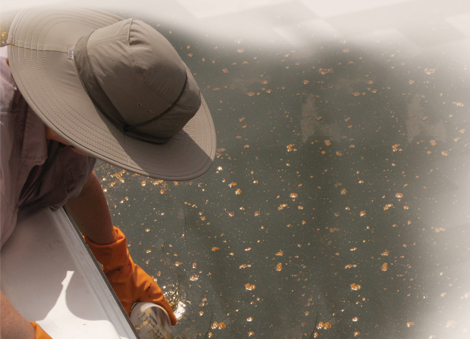On a heavy studio table in UMBC’s Fine Arts building, artist Lisa Moren spreads out a sheet of beautiful marbleized paper, all fine waves and feathering.
But the delicate patterns and the classical images they evoke belie the artist’s main ingredient: pigments derived from oils she collected from the 2010 British Petroleum spill in Louisiana’s Bastian Bay.
“This type of marbleizing is traditionally known from Venetian books, the Renaissance books, and for all those beautiful colors. And mine are very monochromatic and brown,” laughed Moren, whose recent work revolves around the ever-evolving nature of nature, as it relates to sites and their communities.
“All my artwork is brown!”
Moren has spent her career teaching, creating and curating around aspects of technology and the sublime. In recent years, however, as her interest in community interactions and the environment has intensified, her work has taken on the sometimes-murky brownish tones of that research.
This particular itch began in an unlikely place: her kids’ school. Volunteering on the Baltimore Montessori School’s greening committee, Moren unexpectedly found herself thinking anew about ecological relationships as simple – yet vital – as bees and fruit trees. Later, when the opportunity to contribute a water-themed project to Baltimore’s Transmodern Festival presented itself, she followed the impulse straight into Maryland’s waterways.
“I said to myself, almost as an aside, maybe I could make watercolor out of the water,” said Moren, “and so I sort of came up with this laborious way of making watercolor pigments from the water.” She collected samples from the Jones and Gwynn falls, as well as the Chesapeake Bay, boiled them down into pigments, and at the festival, she invited passersby to help stir a Crock Pot full of the tarry substance, which she also used to create a community-driven watercolor postcard project.
Moren used some of the same collected pigments to concoct a greenish-gray “Chesapeake Bay Water Lipstick,” which was displayed (along with her marbleized Gulf papers) last spring in Hydroflow, an exhibit at Goucher College, along with fellow UMBC professors Calla Thompson and Eric Dyer.
“Nobody would want to wear this lipstick,” she joked.
As she explored the Bay’s depths artistically, however, the BP oil spill drew Moren’s attention away from Baltimore. It wasn’t long before she had chartered a small fishing boat and enlisted the help of a friendly Captain Patrick to collect globs of fuel in small bottles from the spoiled waters of Bastian Bay. From those pigments, she produced more than 70 marbleized papers and postcards, each evoking patterns of oils on water.
Most recently, Moren’s research has taken her to south Australia, to ochre-rippled hills once tread by the Dieri tribe, which was wiped out by colonialists during the gold rush of the 1860s. Fascinated by the Dieri’s early economic system driven by the “red gold” they mined from the mountains, Moren based her own “Currentse” project on the very same pigments. Working with residents of the historic town of Bendigo, they printed a sort of faux currency that not only ties each piece of paper to the exact GPS location of its pigment’s origin, but tracks online the fluctuations of the very land’s value over time.
With the care of a researcher, Moren brings to her art a detailed context that allows viewers to better understand the community’s relationship to the environment. And with that same understanding, she follows a strict code of artistic conduct – one of which the Earth would certainly approve.
“It’s very important to me that it’s all natural,” Moren says. “It’s made from nature, or I derived it from what is considered nature…and that whole idea of nature is evolving.”
– Jenny O’Grady
Tags: Fall 2013

